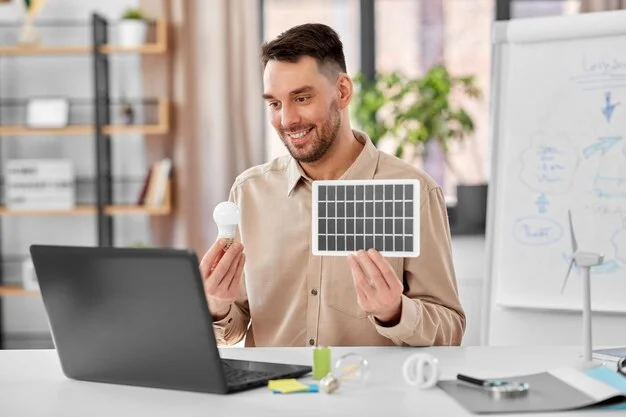When it comes to solar panels, one of the key factors that determine their performance is the cell-to-module ratio. This ratio refers to the number of individual solar cells in a module and plays a crucial role in how much energy a panel can generate. Over the years, as the solar industry has grown, there has been constant innovation in improving this ratio to boost efficiency and lower costs.
But as technology advances, the question arises—has the cell-to-module ratio reached its limit? With current solar panels becoming more efficient, it’s worth exploring whether further improvements can still be made. In this article, we’ll break down the significance of the cell-to-module ratio, its evolution in the industry, and whether we’ve reached the ceiling for what’s possible in solar technology.
What is the Cell-to-Module Ratio?
When you hear the term cell-to-module ratio, you might wonder what it really means for solar panels. Essentially, this ratio represents how many individual solar cells are packed into each module. The number of cells directly impacts how much power the module can produce. The challenge lies in striking the right balance.
How It Affects Solar Panel Performance
More cells generally mean more potential to capture sunlight and convert it into electricity. However, just adding cells isn’t the full picture. It’s all about how these cells work together within the module. The design has to optimize space, wiring, and sunlight absorption. If a module has too many cells crammed together, it could end up reducing efficiency rather than boosting it.
Why Should You Care?
If you’re a homeowner considering solar panels, understanding this ratio is key to getting the most out of your system. Panels with a higher cell count tend to have a higher power output, but they also come with a cost. It’s a balancing act: more cells could mean more electricity, but you have to ensure the panel still makes sense in terms of space, durability, and overall performance. If you’re installing solar panels, this is one factor to consider when evaluating the return on investment for your system.
How the Industry Has Evolved
The solar industry’s approach to the cell-to-module ratio has shifted significantly over time, driven by a need for higher efficiency and lower costs.
- Early Panels: Initially, solar panels featured fewer cells (36-48 per module), which limited their efficiency. This meant larger, less efficient systems that required more space and investment.
- Increased Cell Count: As the demand for better performance grew, panels began to increase the number of cells (up to 72 per module). This boosted energy output without significantly altering the physical size of the panel.
Technological Innovations:
- PERC Technology: Enhanced light absorption through better rear-side cell designs, improving efficiency without extra cells.
- Bifacial Panels: These panels capture sunlight from both the front and back, offering greater energy production without increasing cell count.
- Half-Cell Panels: Splitting cells in half helped reduce power losses due to shading, improving efficiency while maintaining a similar cell count.
Today’s Approach: Solar panels today strike a balance between cell count and efficiency, with technological improvements keeping costs down while boosting performance. However, there’s still potential for further development in the coming years.
Has the Cell-to-Module Ratio Reached Its Limit?
The cell-to-module ratio has evolved, but have we reached its limit? As the demand for solar energy grows, PV module manufacturers are constantly working to improve this ratio, striving to deliver more efficient panels. Advances like PERC technology and bifacial designs are pushing the boundaries of solar energy output, but we may be approaching the practical limit for increasing the number of cells per module.
Current Trends in the Industry
Right now, the standard in residential solar panels typically features 60 to 72 cells per module. These panels are already very efficient, offering good performance for most homes. However, advancements like PERC technology and bifacial panels have shown that there’s still potential for improvement even within these numbers.
Challenges to Further Improvement
- Physical Limitations: There’s a limit to how many cells can be packed into a module without affecting performance. Too many cells can create shading issues or make the panel more prone to damage.
- Cost and Efficiency Trade-offs: While adding more cells might boost efficiency, it often comes at a higher cost, which could make the panels less accessible to the average homeowner.
- Material Limitations: Current solar cell materials already offer a lot of efficiency. Further gains would likely require significant breakthroughs in materials or manufacturing techniques.
So, Is There a Limit?
While technological innovations continue to push the boundaries, there’s a physical and economic threshold to consider. It’s likely that we are nearing the practical limit for the cell-to-module ratio. However, future advancements may focus more on optimizing other factors, such as materials and panel design, to achieve even higher efficiency without simply adding more cells.
What Homeowners Need to Know Before Choosing Their Photovoltaic Modules
When it comes to purchasing solar panels, homeowners should be mindful of the cell-to-module ratio but also consider other factors. Not all panels are created equal, and PV module manufacturers offer different options based on energy efficiency, cost, and design. It’s essential to work with a trusted supplier who offers high-quality panels and cells to ensure the best results for your home’s energy needs.
1. Your Roof Space
Limited Space? If you have a smaller roof, you may need panels with a higher cell count for better efficiency without taking up too much space. Higher-efficiency panels (with more cells) allow you to maximize energy production in tight areas.
2. Energy Needs
- Calculate Your Usage: Understand how much energy your home consumes on a daily basis. Knowing your energy needs will help you determine how much energy your solar system needs to produce, and how many cells per panel are required to meet those needs.
3. Budget
- Upfront Costs vs. Long-Term Savings: While panels with more cells may be more expensive upfront, they can save you money in the long run by producing more energy, reducing your electricity bills.
- Incentives and Rebates: Be sure to explore local government incentives and rebates that may help offset the higher initial costs of higher-efficiency panels.
4. Warranty and Reliability
- Panel Lifespan: Most modern panels come with warranties that last 25 years or more. Choosing panels with a strong warranty ensures that your system remains reliable and efficient for the long term.
5. Installation and Maintenance
- Professional Installation: Proper installation is key to getting the most out of your solar system. Be sure to work with certified installers to ensure your panels are properly set up for maximum performance.
- Low Maintenance: Solar panels require very little maintenance, but you should regularly clean and inspect them to ensure they’re working at their best.
Future Outlook for Cell-to-Module Ratios
The cell-to-module ratio has improved significantly, but there’s still potential for progress. Here’s where we might head next:
- New Materials: Emerging materials like perovskite could improve efficiency without adding more cells, leading to smaller, more powerful panels.
- Advanced Manufacturing: Techniques like nanotechnology or 3D printing could optimize cell production, boosting panel performance without increasing cell count.
- Bifacial and Smart Panels: Bifacial panels capture sunlight from both sides, improving efficiency. Smart panels may adjust dynamically to maximize energy production based on current conditions.
As these innovations take shape, solar panels could become even more efficient and cost-effective, driving wider adoption.
Practical Considerations for Homeowners
When selecting solar panels, consider these key factors:
- Roof Size and Layout: If space is limited, opt for high-efficiency panels with more cells. Ensure your roof has minimal shading for maximum efficiency.
- Energy Needs: Understand your current and future energy consumption. Plan for expansion if you expect higher energy usage.
- Budget: High-efficiency panels may cost more initially but offer long-term savings. Explore financing options and available incentives.
- Reliability: Look for panels with solid warranties (10-25 years) and durability. Invest in panels that require minimal maintenance.
- Professional Installation: Hire certified installers to ensure proper setup and optimal performance.
By focusing on these aspects, you’ll choose the right solar panel system for your home’s needs.
Conclusion
The cell-to-module ratio has seen significant improvements, but there’s still room for innovation. As technology evolves, PV module manufacturers are continuing to refine their designs to maximize efficiency and performance. At the same time, working with a reliable solar cell supplier is essential to ensure that the cells used in these panels are of the highest quality, which contributes to the long-term success of your solar investment.
As the solar industry progresses, expect to see even more advancements that further optimize the cell-to-module ratio, making solar energy even more accessible and cost-effective. With the right choices, homeowners can enjoy a cleaner, more efficient energy future.
What is the cell-to-module ratio?
It refers to the number of solar cells in a panel module. The higher the ratio, the more cells in a module, which usually leads to higher energy output.
Has the cell-to-module ratio reached its limit?
While the ratio has improved significantly, advancements in materials and technologies like bifacial panels and perovskites suggest there is still room for growth.
How does the cell-to-module ratio affect panel efficiency?
A higher cell count typically means higher efficiency, as more sunlight can be captured and converted into electricity, though the design must still optimize for performance.
Can a higher cell-to-module ratio impact the cost of panels?
Yes, increasing the number of cells can raise manufacturing costs, but it might also lead to better long-term savings by increasing energy production.
What factors should homeowners consider when choosing solar panels?
Consider roof space, energy needs, panel efficiency, warranty, and installation costs. The cell-to-module ratio is important, but it should be balanced with other factors like durability and cost.







